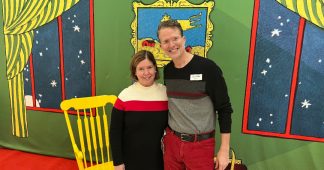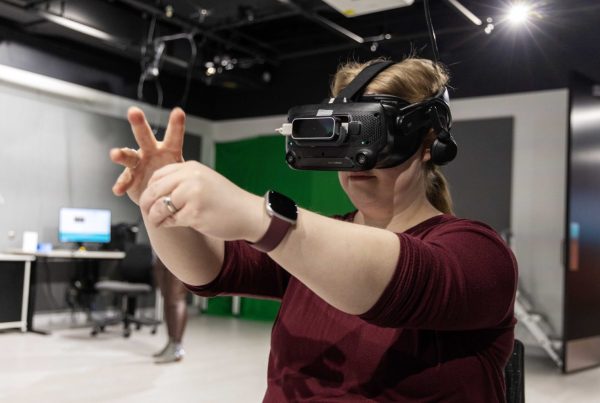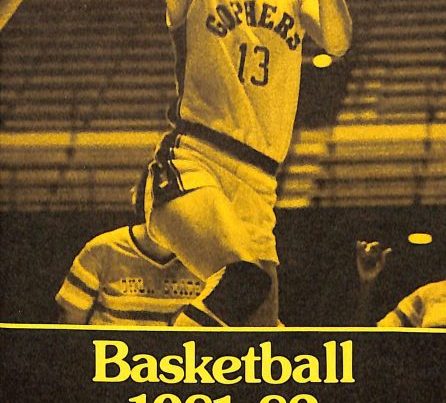By Allison Campbell-Jensen
The aromas have changed since Darren Terpstra started his career, he says: “going from corn dogs and cotton candy to the smell of antiquity.” The threads, however, tying his current position as exhibition designer for the University of Minnesota Libraries with his first work at amusement parks remain the same.
He always brings to his work a love for design, a commitment to visual excitement, and the goal of grabbing the attention of people who range from Regular Folks to Scholarly Experts. It’s challenging to educate such a diverse audience, yet often it’s fun. And, to hear him tell it, it’s always done as frugally as possible.
Budget matters
Entering Terpstra’s office in Andersen Library feels like going backstage — but with Greek columns, a Chinese dragon head, and midcentury lamps, one is not sure which play will be performed. Well, it depends on who is the director — erm, curator!
The dragon head was originally created with red fabric, felt, and geegaws from a local craft store to add ambiance to a Kautz Family YMCA Archive display about the ‘Y’ in China. The dragon’s head reappeared later in one of the exhibitions Terpstra dreamed up with Marguerite Ragnow, Curator of the James Ford Bell Library.
“There’s a lot of reusing and upcycling here,” Terpstra says. “We’re kind of lean on our budgets.” Now in storage, a large, premodern sailing ship modeled from foam core has potential for a future exhibition — another example of flexible design.
Creativity matters
As we all know, necessity is the mother of invention. Even so, the lean budgets can be used best with several heaping measures of creativity plus the application of the eyes of an artist — or two or three or four pairs of eyes.
While the display of Adger Cowans’ archive was coming together, the reporter dropped in to see two to three people bringing together a wealth of photographs, paintings, journals, old cameras, and rare photography exhibit catalogs to develop a whole exhibition: The Eyes See What the Heart Feels.
From Hollywood stills of Eddie Murphy, Grace Jones and Jane Fonda, to group portraits of a Black photographers’ guild, paintings, and embroideries, Cowans’ artist’s viewpoint was being analyzed and curated by Deborah Ultan, Curator of the Gorman Rare Art Books and Media Collection, with some curatorial assistance from her colleague arts educator Barbara Cox.
Terpstra brought his lens of appreciation of Cowans’ work to his collaboration with Ultan: Their synergy made the resulting exhibit really pop, Ultan says.
Terpstra and Ultan related that earlier, he was showing her ideas for depicting the water theme when the phone rang. It was the subject of the exhibition, the famed photographer and multimedia artist Adger Cowans, and Steven Albahari of 21st Editions.
Initially a bit rattled by Cowans’ reputation, Terpstra said to Ultan: “I don’t think I’m prepared for this!”
No matter: Like being shoved off the diving board into a pool, Terpstra and Ultan quickly surfaced, to rise to the occasion. The illuminating 40-minute video call with the artist and his publisher distilled the water theme that unites the myriad works by this prolific artist on display through Jan. 31, 2023, in the Andersen Library exhibition area on the first floor.

Darren Terpstra (at right) and Dean of Libraries Lisa German pause for a moment in front of a mock up from the children’s book “Good Night Moon.”
Curatorial matters
Along with displaying Cowans’ artistry, Ultan adds that she has three other goals. She wants to:
- Capture the cultural moment and context of the artist’s work,
- Invite people to hear the voice of the artist and his contemporaries, and
- Leverage Cowans’ own abundant and significant archive to illuminate his legacy
“There are so many layers to putting together an exhibition of an archive,” Ultan says. “I’m superambitious” but was not sure if she and the team can reach all these goals. “That’s what Darren is here for: He can support my goals as a curator with his talent to help stage the materials.”
Their mercurial natures mesh well for the speedy development of a living artist’s portrait in photographs, paintings, objects, and books.
On display with the newly published 21st Edition artists’ book “ADGER” are two significant books that contextualize Adger Cowans’ interest in the spiritual and musical nature of art: Vassily Kandinsky’s “Concerning the Spiritual in Art” and Henri Matisse’s “Jazz,” one of the first major artist’s books.
The U of M Libraries having recently acquired the complete 21st Editions collection and archive, Ultan took the opportunity to show three other 21st Editions exquisitely crafted book productions that tie in beautifully with “ADGER,” including “COLOUR,” “BLUE,” and “LISTEN: Herman Leonard and his World of Jazz.”
Stopping to mull over a question about creativity, Ultan and Terpstra pause. In conversation, they each reflect that they like to fill up with the material, become “super-saturated” by all its parts and meanings, and, if there is time, go meditate, do yoga, weed the garden or do something else seemingly mindless. Turning attention away from the puzzles and layers often allows the deep brain to do its work, to offer the metaphors or organizational principles that make an exhibition into something unexpected, even surprising.
Working for a show featuring a living artist, Terpstra says, is exciting and a little nerve-wracking.
“I want them to say: ‘Oh my God, this is amazing! I love how you have framed my work.’”
Cowans was blown away and is still talking about the premiere exhibition of his archive, his paintings, and his artistic legacy. There’s still time to take it all in: Adger Cowans and the Temple Trio return to celebrate the exhibit’s final days on Jan. 19, from 5:30 to 7:00 p.m. Watch for more information and registration.
Archives and Special Collections — Disneyfied
As he stood back from his first U of M Libraries exhibition in 2006, featuring the Guthrie Theater art, artifacts, and actors, he says the realization sprang from his mind: “Oh! … I’ve Disneyfied the exhibition! … They are going to fire me.”

This lunch counter from the Jim Crow era occupies an exhibition about a book by Andrea Davis Pinkney.
Nope. Instead, he was promoted from part-time to full-time.
Ragnow is happy with that outcome because, from working solo, she has come to rely on Terpstra as a collaborator.
“If he wasn’t here it would be fine,” she says. “But you know he’ll give it background, and he’ll give it depth, and he will take it to that next level.
“Collaboration usually makes something stronger and better, because you’ve got more brains coming at it.” Ragnow adds: “Everything is better when you have more than one perspective.”
She can draft her concepts for exhibitions, even choose the colors she’d prefer, and copy the text. She also likes to have some “flash” in her exhibits. She trusts Terpstra’s skillful eye and active imagination to add that flash — turning any display into a trip off the beaten track.
An exhibition can be transformed from a typical books under glass to a defined place that conveys, for the Bell Library’s curator, what a slice of life was like in the pre-modern world.
Their combined creativity boosts the words and objects into an immersive experience. “Because,” Ragnow says, “you don’t want people to focus on the decor. You want them to enter an atmosphere” — to enter a space that is Disneyfied, in the best possible meaning of that term.





